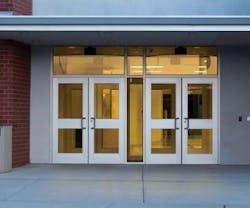Choosing the Best Doors for Your Buildings
Doors and entrances often give visitors and tenants the first impression of your building. Have you spent adequate time researching and specifying the best doors for your application? Use the following advice from experts to make smart door choices.
Priorities
“You’re not going to be able to change the way a door is used, and there isn’t much you can improve in maintenance techniques, so it comes down to which door you specify,” says Dan Depta, manager of marketing at Special-Lite Inc., Decatur, MI. When you begin the task of buying new doors or upgrading old or damaged ones, make sure you get your priorities straight. Longevity and performance should, if you think about it, outweigh initial cost – at least to an extent. “More facility managers are taking the longer view and paying the premium for a performance product – weighing the total cost of owning and maintaining a door against its initial cost,” says Depta, who suggests evaluating doors by structural strength, thermal performance, any contribution to indoor air quality, and resistance to corrosion/chemicals/weather/moisture.
“In general,” he says, “you’re looking for a tightly sealed door that’s lightweight and flexible. Contrary to popular belief, only in rare situations will a heavyweight door be preferable to a sturdy, lightweight door.”
Different Applications
Knowing when to use a heavyweight vs. lightweight door is a matter of specific applications and knowing the codes. “There are many challenges based on national and local codes,” says Michael Phillips, director of brand management at Pomona, CA-based Adams Rite Manufacturing Co. “For instance, areas of the Southeast, the Gulf Coast, and throughout the Midwest could be governed by windstorm/hurricane/wind-load standards that will affect the type of door and hardware used. In some cases, as with storefront entrances, doors and frames must be tested as a system.”
In high-abuse areas, like schools, hotel ballrooms, and warehouses, Stan Hubbell, service manager at Pontiac, MI-based Total Door, recommends using doors reinforced for structural integrity that have the proper controls. “Shipping/receiving doors and loading docks should have dogged panics, as carts are often used as battering rams to open doors. If they’re dogged in the unlocked position, the door will begin the opening cycle on impact,” he says.
Phillips also recommends looking ahead when specifying doors. “Consider present and future uses,” he says, “especially when it comes to access control and alarm monitoring. It’s much easier, cleaner, and less expensive to pre-wire the door and frame during the construction phase than to retrofit.”
Emerging Trends
Pre-wiring could be a great idea, as Hubbell notes the increasing use of access-control technology in entries. “The advancement of electronic access control/monitoring for exterior doors is advancing at a feverish pace,” he says. Phillips also mentions the trend of specifying energy-efficient openings. “Over the next decade, I expect to see thermal ratings imposed on exterior doors,” he says. “Thermally efficient openings will be an integral part of the overall goal of reducing energy usage throughout the building.”
Jenna M. Aker ([email protected]) is associate editor at Buildings magazine.
